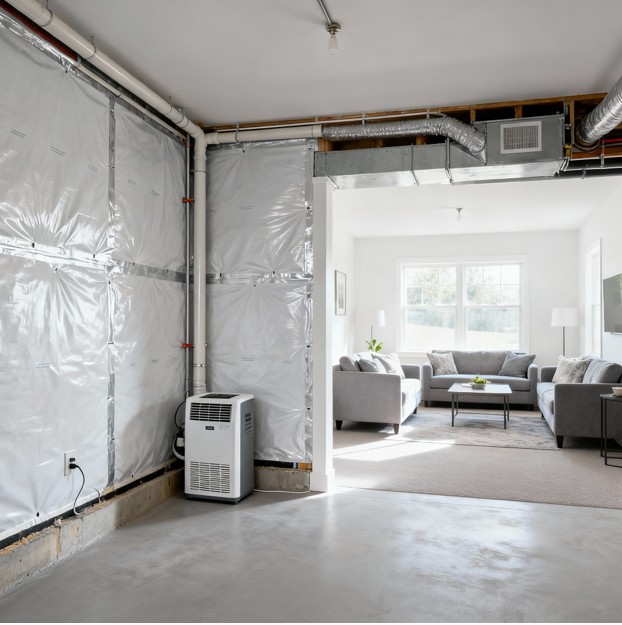 Walking into a basement shouldn’t feel like entering a science experiment gone wrong, yet many homeowners find themselves dealing with musty odors, visible mold spots, and that distinctive dampness that clings to everything. The good news? Understanding how comprehensive mould removal and remediation services work hand-in-hand with preventive measures, combined with effective mould remediation services and waterproofing solutions, can transform even the moldiest basement into a healthy, functional space your family can actually enjoy.
Walking into a basement shouldn’t feel like entering a science experiment gone wrong, yet many homeowners find themselves dealing with musty odors, visible mold spots, and that distinctive dampness that clings to everything. The good news? Understanding how comprehensive mould removal and remediation services work hand-in-hand with preventive measures, combined with effective mould remediation services and waterproofing solutions, can transform even the moldiest basement into a healthy, functional space your family can actually enjoy.
Basements get an unfair reputation as naturally damp, musty spaces where mold just “happens,” but this doesn’t have to be your reality. The secret lies in understanding that mold prevention isn’t about treating symptoms after they appear; it’s about creating conditions where mold simply can’t thrive in the first place. When waterproofing and structural improvements like underpinning work together, they create a powerful defense system that protects your home’s foundation, your family’s health, and your investment’s value.
Why Basements Become Mold’s Favorite Hangout
Think of your basement as a below-ground box surrounded by soil that holds moisture like a sponge. Every time it rains, that moisture pushes against your foundation walls, looking for any tiny weakness to exploit. Combine this constant moisture pressure with typically cooler temperatures and limited air circulation, and you’ve created a mold paradise. It’s like setting up a five-star resort for spores and then wondering why they checked in.
The relationship between foundation integrity and mold prevention is more interconnected than most people realize. Small cracks in foundation walls aren’t just structural concerns; they’re express lanes for groundwater to enter your basement. Once moisture finds its way inside, it doesn’t just puddle on the floor (though that happens too). It seeps into concrete pores, collects behind walls, condenses on cold surfaces, and creates the perfect humidity levels for mold colonies to establish themselves.
Triangle Gardener’s landscaping hacks that complement exterior waterproofing demonstrate how outdoor drainage solutions work synergistically with foundation protection to keep water away from your home’s vulnerable below-grade spaces. Understanding that mold prevention starts outside your home’s walls represents a mindset shift that pays dividends in long-term basement health.
How Waterproofing Creates an Impenetrable Moisture Barrier
Proper basement waterproofing isn’t a single product you slap on walls and call it done. It’s a comprehensive system that addresses moisture from multiple angles, much like a castle has layers of defensive walls rather than relying on a single gate. Exterior waterproofing involves excavating around your foundation, applying waterproof membranes directly to exterior walls, and installing drainage systems that redirect groundwater away from your home before it ever touches your foundation.
Interior waterproofing complements this external defense by managing any moisture that does make it through. Delta membranes installed along interior foundation walls channel water down to weeping tiles, which then direct it to sump pumps that efficiently remove it from your basement. This two-pronged approach means that even if exterior waterproofing encounters a breach, your interior systems catch any moisture before it can create the damp conditions mold requires.
The beauty of comprehensive waterproofing lies in its ability to control humidity levels proactively. When foundation walls remain consistently dry, basement air naturally maintains lower humidity levels. This creates an environment fundamentally hostile to mold growth, no matter how many spores float through the air. It’s the difference between trying to grow tomatoes in a desert versus a greenhouse; the environment determines success far more than the presence of seeds.
Modern waterproofing materials have evolved dramatically beyond the tar-based coatings of previous generations. Today’s systems incorporate crystalline technology that actually reacts with moisture to grow crystals within concrete pores, creating self-sealing capabilities that strengthen over time. Advanced membranes with dimpled designs create air gaps that allow any trapped moisture to evaporate rather than accumulating. These technological improvements mean waterproofing systems installed today can protect your basement for decades with minimal maintenance.
The Underpinning Connection: Stronger Foundations Mean Drier Basements
Underpinning might sound like an obscure construction term, but its role in mold prevention deserves recognition. This process involves strengthening and often deepening your home’s foundation by excavating beneath existing footings and extending them further into stable soil. While primarily performed to address structural issues or create additional headroom, underpinning provides an exceptional opportunity to implement comprehensive waterproofing measures simultaneously.
When contractors excavate around and beneath your foundation during underpinning work, they expose foundation surfaces that typically remain hidden for a home’s entire lifespan. This access allows for thorough inspection of foundation condition, identification of any existing cracks or weaknesses, and application of waterproofing systems to every inch of exposed foundation surface. It’s like getting a complete health screening that discovers problems before they become serious, except for your home’s structural bones.
The process of underpinning also addresses one of the sneakier causes of basement moisture: foundation settlement. When foundations settle unevenly, even slight movements can create new cracks or worsen existing ones, opening pathways for water intrusion. By stabilizing foundations and preventing future settlement, underpinning eliminates a major source of the cracks through which moisture invades. A stable foundation maintains its integrity and waterproofing effectiveness far better than one constantly shifting and settling.
Combining underpinning with comprehensive waterproofing creates a basement transformation that addresses both structural integrity and moisture control simultaneously. Foundation walls become reinforced and waterproofed in a single project, dramatically reducing future maintenance needs and virtually eliminating mold risk. For homeowners planning basement renovations or dealing with recurring moisture issues, timing underpinning with waterproofing represents the most cost-effective approach to creating a permanently dry, healthy basement space.
Creating Lasting Mold Prevention Through Moisture Management
Once waterproofing and structural improvements create a moisture-resistant basement envelope, maintaining that protection requires ongoing moisture management strategies. The relationship between humidity control and mold prevention cannot be overstated; mold requires moisture levels above 60% to thrive, so keeping humidity consistently below 50% essentially creates an environment where mold cannot survive.
Dehumidifiers serve as your first line of defense in humidity control, but not all dehumidifiers perform equally. Basement environments require units with sufficient capacity to handle large volumes of air while operating efficiently in cooler temperatures. Look for models with built-in pumps that automatically remove collected water rather than requiring manual bucket emptying. Smart dehumidifiers with humidity sensors maintain optimal levels automatically, adjusting operation based on real-time conditions without constant attention.
Ventilation works hand-in-hand with dehumidification to maintain healthy air quality. Basements naturally experience less air circulation than upper floors, allowing moisture and stale air to accumulate. Installing exhaust fans in laundry areas, bathrooms, or anywhere steam and humidity generate helps remove moisture at its source before it disperses throughout your basement. Opening windows when weather permits introduces fresh air that dilutes humidity and carries moisture outside.
Regular monitoring helps you catch moisture problems before they escalate into mold colonies. Simple hygrometers (humidity meters) cost less than dinner out but provide invaluable information about basement conditions. Place them in different areas to identify moisture-prone zones that might need additional attention. When humidity readings creep above 50%, investigate potential sources: Are gutters clogged? Did a recent heavy rain overwhelm drainage systems? Has something changed in how you use the space?
The Health and Value Benefits of Mold-Free Living Spaces
Creating a mold-free basement through proper waterproofing and structural integrity delivers benefits that extend far beyond eliminating musty odors. Indoor air quality improvement throughout your entire home represents one of the most significant health advantages. Mold spores don’t respect floor boundaries; they circulate through HVAC systems and natural air movement, affecting air quality on every level of your home. Eliminating basement mold sources means cleaner air for your entire family.
Respiratory health improvements often surprise homeowners who didn’t realize how much basement mold affected their daily wellbeing. Chronic coughs, frequent sinus issues, unexplained allergies, and persistent fatigue often diminish or disappear entirely once basement mold problems are resolved. Children and elderly family members, whose respiratory systems are more vulnerable, benefit most dramatically from improved air quality. It’s remarkable how “normal” poor air quality can feel until you experience what truly fresh, clean indoor air should be.
Property value protection represents another substantial benefit of comprehensive mold prevention. Home inspections increasingly focus on moisture issues and mold presence, with even minor problems potentially derailing sales or slashing offer prices. Buyers rightfully view basement moisture and mold as red flags indicating deferred maintenance and potential costly repairs. Conversely, homes with documented waterproofing systems, structural improvements, and demonstrably dry basements command premium prices and sell faster.
The ability to actually use your basement as functional living space rather than glorified storage for things you’re afraid to keep upstairs changes how your entire home functions. Finished basements add significant square footage for family rooms, home offices, guest suites, or recreation areas. But finishing a basement without first addressing moisture and mold risks wastes money and creates health hazards. Proper waterproofing and mold prevention must come first; beautiful finishes follow naturally once you’ve created a genuinely dry, healthy space.
Strategic Timing: When to Tackle Waterproofing and Foundation Work
Understanding optimal timing for waterproofing and underpinning projects helps homeowners plan effectively and maximize cost efficiency. Waiting until you have active mold growth or obvious water intrusion means you’re already dealing with damage that requires remediation before prevention measures can even begin. Proactive waterproofing, especially in older homes or those built before modern waterproofing standards, represents smart maintenance that prevents problems rather than reacting to them.
Combining multiple projects creates substantial cost savings by eliminating duplicated work. If you’re planning basement renovations, address waterproofing and any necessary structural improvements before investing in finishes. If foundation issues require underpinning work, add comprehensive waterproofing to the project scope since foundations will already be exposed. This Old House’s guide to keeping basements mold-free emphasizes that preventing mold is exponentially easier and more cost-effective than remediating established growth.
Seasonal considerations influence project feasibility and cost. Spring through fall offers ideal conditions for exterior waterproofing and underpinning work, as frozen ground and extreme cold complicate excavation and material application. However, interior waterproofing can proceed year-round, making it a viable option when exterior work isn’t seasonally feasible. Planning ahead and scheduling during optimal weather windows helps projects proceed smoothly and stay within budget.
Financial planning deserves attention given that comprehensive waterproofing and underpinning represent significant investments. However, viewing these projects through a cost-benefit lens that includes prevented damage, avoided health issues, and increased home value demonstrates their true worth. Many homeowners discover that waterproofing costs less than they feared, especially when compared to the expense of repairing mold damage, replacing ruined belongings, and dealing with potential health consequences.
Maintaining Your Mold-Free Basement Long-Term
Creating a mold-resistant basement environment represents a significant achievement, but maintaining that protection requires ongoing attention and periodic maintenance. Establishing simple monitoring routines helps catch small issues before they become major problems. Monthly visual inspections of basement walls, floors, and ceilings for any signs of moisture, new cracks, or musty odors take just minutes but provide early warning of potential issues.
Gutter and downspout maintenance ranks among the most important yet overlooked aspects of basement moisture prevention. Clogged gutters overflow during rain, dumping water directly against your foundation rather than directing it away. Clean gutters at least twice yearly, more often if you have trees near your home. Ensure downspout extensions direct water at least six feet away from your foundation, not just dumping it at the base of your walls.
Sump pump testing should occur regularly, especially before heavy rain seasons. Pour water into the sump pit to verify the pump activates, removes water efficiently, and shuts off properly when water levels drop. Battery backup systems need annual testing to ensure they’ll function during power outages, which often coincide with severe storms when you need your sump pump most. Replacing aging pumps before they fail prevents the emergency situations that lead to flooding and mold growth.
Landscaping around your home affects basement moisture more than many people realize. Ensure ground slopes away from your foundation, maintaining at least a six-inch drop over the first ten feet. Avoid planting large bushes or trees directly against your foundation, as their roots can damage waterproofing systems and they can block air circulation that helps walls dry. Consider how irrigation systems are positioned to avoid directing water toward your home.
Moving Forward with Confidence
Taking control of basement moisture and mold prevention through proper waterproofing and structural improvements transforms one of your home’s most problematic spaces into valuable, healthy square footage. The investment required might seem substantial initially, but the long-term benefits in health protection, property value, and peace of mind far outweigh the costs. You gain a basement space you can actually use, air quality improvements throughout your home, and freedom from the constant worry about what’s growing behind your walls.
Starting with thorough assessment by qualified waterproofing and foundation specialists provides the roadmap for your specific situation. Every home presents unique challenges based on age, construction methods, soil conditions, and drainage patterns. Solutions that work perfectly for one home might be overkill or insufficient for another. Professional evaluation identifies your basement’s specific vulnerabilities and recommends appropriate remediation strategies.
The journey from mold-prone basement to healthy, dry living space doesn’t happen overnight, but every step forward improves your home and your family’s wellbeing. Whether you’re addressing active problems or proactively preventing future ones, understanding how waterproofing, structural integrity, and moisture management work together empowers you to make informed decisions that protect your home for decades to come.
Your basement doesn’t have to be that damp, musty space everyone avoids. With proper waterproofing, structural attention when needed, and ongoing moisture management, it can become valuable space your family enjoys using. The mold-free basement you envision isn’t just possible; with the right approach, it’s entirely achievable and maintainable for the long term.






